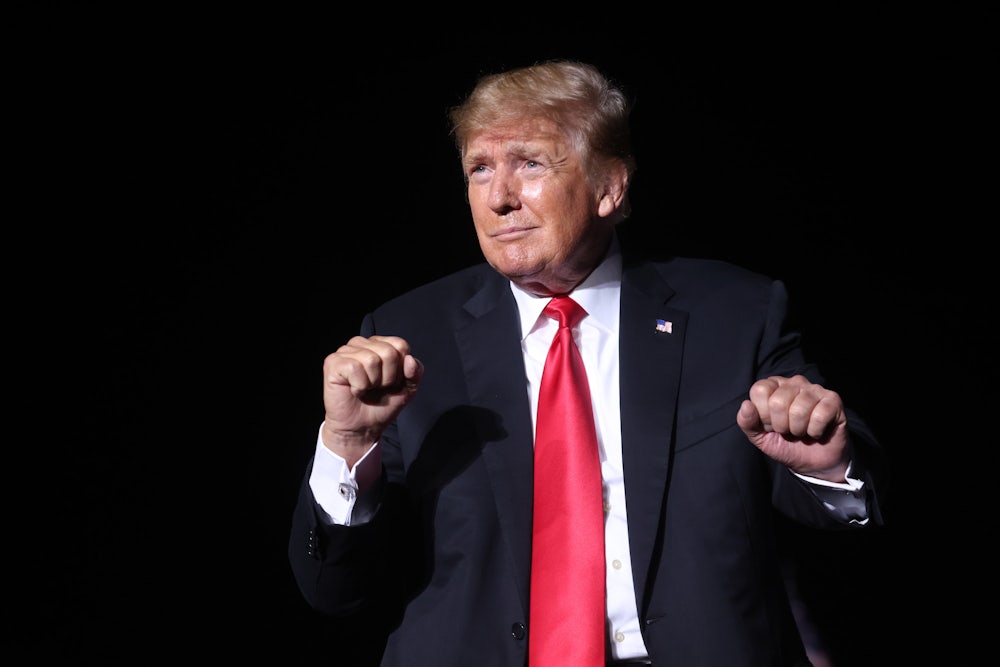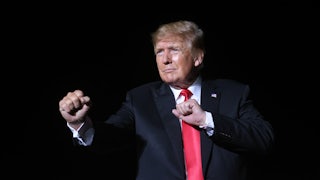For most of Virginia’s gubernatorial race this year, Democrat Terry McAuliffe had a simple strategy for dealing with his Republican opponent, private equity baron Glenn Youngkin: Make the election a referendum on Donald Trump. With polls tightening in the lead-up to last Tuesday’s election, McAuliffe turned up the heat, calling his opponent a “Trump wannabe” and including footage of the January 6 riot at the Capitol in his closing advertisements. Days before the election, a Washington Post headline noted that the race “tests the fear-of-Trump factor as a political motivator,” while a New York Times report noted that McAuliffe mentioned Trump’s name 13 times in a recent 15-minute speech.
McAuliffe, after falling behind Youngkin in the polls, seemed to pivot in the final days of the race, declaring that the election was “not about Trump.” It proved too late. Youngkin pulled off the upset, and political pundits quickly cited McAuliffe’s Trump-heavy strategy as the reason he lost—and why Democrats shouldn’t attempt that strategy in next fall’s midterm elections.
For some, particularly on the right, this was vindication: Finally, Trump-obsessed Democrats were getting their just deserts. “It is looking like Terry McAuliffe’s campaign against a certain person named ‘Trump’ has very much helped Glenn Youngkin,” Trump wrote in an email to supporters. Politico’s Charlie Sykes observed, “Running against Trump is apparently not a winning formula when the former president is merely a spectral presence.” All heralded McAuliffe’s loss—and New Jersey Governor Phil Murphy’s shockingly tight reelection win—as a harbinger of doom. Republicans had a new playbook, written by Youngkin, who was successfully able to keep the former president at arm’s length: Come 2022, they would use it to win races across the country.
But this analysis, which immediately became the conventional wisdom, makes several mistakes. Trump was curiously quiet in this year’s races. That simply will not be the case next year, when Trump—barring some kind of health emergency—will be crisscrossing the country to froth up his base. This, in turn, may very well renew the potency of anti-Trump campaigning among Democrats, suggesting Virginia’s race might be something of an outlier: a rare election between 2016 and 2024 that isn’t obsessively focused on Trump—however much McAuliffe wanted it to be.
It is not simply that McAuliffe lost the race; Youngkin won it, specifically by making the race not about Trump. Here, too, the commentariat is in near-universal agreement: Youngkin kept the divisive former president just far enough away to win over moderates and suburbanites but just close enough to keep him and his die-hard supporters on his side.
The Wall Street Journal noted the deftness with which Youngkin “navigated the narrow path between embracing the former Republican president’s policies without being drawn into a debate about Mr. Trump himself.” The New York Times marveled at the way Youngkin “managed to keep the former president at a politically safe remove without alienating him or his allies.” CNN, meanwhile, observed that Youngkin “wrote a new Republican playbook for keeping Donald Trump’s base engaged without alienating the voters who were repelled by the former President in recent elections.”
While pundits duke it out over what role Democratic disarray and “critical race theory” played in the race, Youngkin is acknowledged in almost every source as a kind of Republican Goldilocks. For years, GOP politicians have struggled to balance political imperatives with Trump’s unceasing demands for attention and peerless ability to generate publicity for himself—even at the expense of his larger political project. And yet, during the six years after Trump took over American politics, no Republican was able to figure that out. Until Glenn Youngkin.
To a large extent, Youngkin benefited from an old political trick. During the primary, he touted his “electoral integrity task force” to woo Trump and his supporters. Although he wasn’t the most extreme candidate in the race, he did enough to make it clear that he was backing the president’s widespread claims of voter fraud. Youngkin was coy as to whether he considered Joe Biden’s victory legitimate. After months of playing footsie with election conspiracy theories, Youngkin acknowledged that “of course” Biden won—but not until May, after he had sewn up the party’s nomination. Months later, when Trump was publicly questioning his MAGA bona fides, Youngkin did the same dance again: He refused to answer a question about whether he would have certified Biden’s electoral victory, then days later said that he would have.
Talking out of both sides of his mouth on Trump’s most bombastic claims about the 2020 election did a great deal for Youngkin. So did embracing “critical race theory,” one of Trump’s pet causes. Here, too, Youngkin benefited from sanding off the former president’s rough edges, curtailing Trump’s belligerent and often racist assertions, and instead hammering his opponent on the importance of ensuring that parents had a voice in their children’s education. His position was extreme and often borderline authoritarian—his closing message revolved, in part, around the necessity of allowing parents to opt their children out of reading Toni Morrison’s Beloved, but it was delivered with something approaching subtlety. The issue wasn’t that white children were learning about America’s racist past—even though, deep down, it was. It was that parents were worried about what their children were being taught at school and Democrats like McAuliffe were refusing to let them have a say.
Above all, though, Youngkin benefited from the absence of Trump. As the race tightened, McAuliffe and his allies hammered Youngkin’s connections to Trump and tried to draw the former president into the race. It didn’t work. Trump did a “tele-rally” for Youngkin, but the gubernatorial candidate didn’t participate. Instead, Trump largely sat out Virginia’s race, aside from a series of statements and radio interviews. That allowed Youngkin to make a plausible case that he wasn’t a “Trump wannabe.”
There is no discounting that the level of engagement on the right at the moment is extraordinary, and that a “red wave” election next fall is likely; at the very least, Republicans seem guaranteed to retake at least one chamber of Congress. And yet, the playbook that Youngkin used seems unlikely to work for Republicans in the midterm elections. For one thing, it was highly specific to Youngkin’s state. Virginia is purple but increasingly blue and is politically defined by the Washington, D.C., suburbs. That will not be the case for many Republicans running next fall. But for those that do, there is an argument to be made that Youngkin’s new “playbook” didn’t work all that well. He outperformed the state’s previous Republican candidate, Bob McDonald, in northern Virginia’s suburbs by about five points—no small achievement but also not necessarily a blaring siren for Democrats, either.
But also, it’s hard to imagine that Trump will stay out of the midterms the way he sequestered himself in Mar-a-Lago during the home stretch in Virginia’s race. Trump loves political rallies, and he loves making himself the center of attention. Even if the party succeeds in keeping him away from suburban House races and swing-state Senate races, there will be scores of right-wing Republican candidates who eagerly want him to campaign with them. Trump will, of course, abide. He’ll say things on the stump that will propel him back into the forefront of American politics, making it impossible for any Republican to avoid his shadow. Democrats will use the things he says at rallies to motivate voters who may not have turned out for McAuliffe—and to tarnish the few Republicans who do try to use the Youngkin playbook. (Trump’s social media presence is more of a wild card. It seems unlikely he’ll be reinstated by Twitter and Facebook, but he’s working on his own social media platform that will undoubtedly be covered by the mainstream press.)
We are in the midst of what is probably the nadir of Trump’s public profile. For many of us, it has been a welcome reprieve from his ceaseless, years-long onslaught of racism, bigotry, and authoritarianism (not that some Republicans haven’t tried to fill that vacuum). Enjoy it while it lasts. Come next year, the former president’s gaping, mop-topped orange face will greet us with every click of the remote and mouse. Some Democratic candidates will—like McAuliffe, and Hillary Clinton before him—respond by lazily centering their campaigns on the persistent threat of Trumpism. But the smart ones will let Trump himself do that work and focus instead on what Democrats are proposing in its place.






